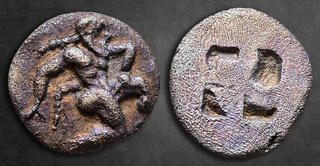| Savoca Numismatik GmbH & Co. KG > Online Auction 203 | Silver | Auction date: 24 March 2024 |
| Lot number: 63 Price realized: 55 EUR (Approx. 60 USD) Note: Prices do not include buyer's fees. | Show similar lots on CoinArchives Find similar lots in upcoming auctions on |
| Lot description: Islands off Thrace. Thasos circa 510-480 BC. Diobol AR 11 mm, 0,72 g Satyr running right / Quadripartite incuse square. Very Fine Le Rider, Thasiennes 4; HGC 6, 333; Rosen 144. Thasos, an island located in the northern Aegean Sea, was renowned in antiquity for its rich natural resources, particularly its mines that yielded valuable metals such as gold, silver, and especially, high-quality marble. The island's prosperity enabled it to become a significant center of trade and commerce in the ancient Greek world. On the obverse side of the diobols, a Satyr is depicted running to the right. In Greek mythology, Satyrs were woodland deities associated with nature, revelry, and fertility. Depictions of Satyrs were common in Greek art and literature, often portrayed as half-human, half-horse creatures with goat-like features. The presence of a Satyr on the coinage of Thasos may reflect the island's connection to the worship of Dionysus, the god of wine, fertility, and ecstatic revelry, with whom Satyrs were closely associated. On the reverse side, the coin features a quadripartite incuse square. This design consists of four compartments or sections incused into the surface of the coin in a square pattern. The purpose of the incuse design was primarily to deter counterfeiting by making it more difficult to tamper with the coin's metal content. Additionally, the incuse square may have served as a convenient way to verify the weight and authenticity of the coin in trade transactions. Starting price: 50 EUR |  |


